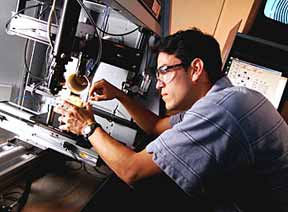Body
 |
CardioMEMS engineer Michael Fonseca uses a laser to separate pressure sensors in the company’s clean room facility in the ATDC Biosciences Center located at Georgia Tech’s Environmental Science and Technology Building. Photo by Gary Meek |
After winning a thumbs-up from the Food and Drug Administration, CardioMEMS Inc. has launched its EndoSure sensor, which makes testing safer and more convenient for aneurysm patients.
Based on intellectual property of the Georgia Institute of Technology, EndoSure is the first implantable pressure sensor that combines wireless and microelectromechanical system (MEMS) technology to receive FDA clearance.…
Want to continue?
Log in or create a FREE account.
By logging in you agree to receive communication from Quality Digest.
Privacy Policy.
Add new comment